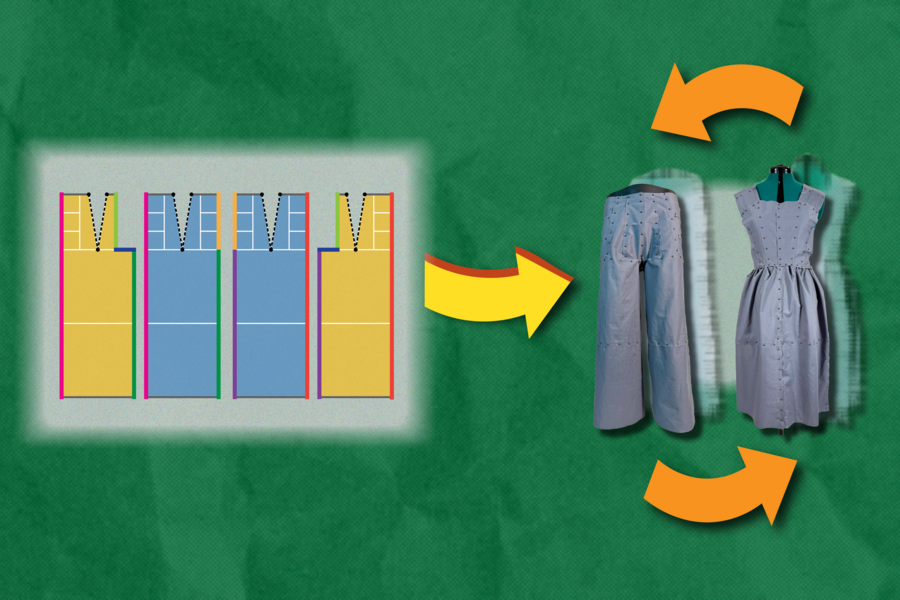The rapid currents of the fashion industry pose a persistent challenge for consumers. Styles considered ‘in vogue’ one season can swiftly become obsolete the next, frequently prompting individuals to re-evaluate and update their personal wardrobes.
Keeping pace with the fashion world’s relentless cycles extracts a heavy toll, both financially and environmentally. Each year, an astounding 92 million tons of textile waste are generated globally, a figure significantly driven by garments discarded simply because they’re no longer in vogue or have ceased to fit. This raises a compelling question: What if we could fundamentally transform our wardrobes, reassembling existing clothes into entirely new outfits, thereby effortlessly adapting to emerging trends and the natural evolution of our bodies?
Researchers at MIT’s Computer Science and Artificial Intelligence Laboratory (CSAIL), in collaboration with Adobe, are spearheading an initiative to infuse sustainability and versatility into garment design. Their innovative “Refashion” software system aims to revolutionize how clothing is conceived and constructed.
The platform operates by deconstructing fashion design into modular components, allowing users to digitally plan, visualize, and sketch each individual element of a clothing item. Refashion then translates these creative concepts into a precise blueprint, outlining the assembly process for reconfigurable apparel. This advanced tool facilitates the creation of multi-functional garments, such as a pair of pants that can transform into a dress, ultimately promoting eco-friendly practices and reducing textile waste.
**Refashion Transforms Clothing Design with Adaptable Garments**
An innovative design platform named Refashion is poised to revolutionize how clothing is created, allowing users to graphically compose shapes to develop outlines for remarkably adaptable fashion pieces. This visual diagramming tool provides intuitive blueprints for garment construction, enabling the creation of versatile items that can easily transform to suit various needs.
For instance, designers can create a shirt with a detachable hood perfect for unpredictable weather, or a skirt that can be reconfigured into an elegant dress for a formal dinner. The system also supports the design of maternity wear that fluidly adapts to different stages of pregnancy, offering prolonged utility.
“We wanted to create garments that consider reuse from the start,” explains Rebecca Lin, an MIT Department of Electrical Engineering and Computer Science (EECS) PhD student, researcher at CSAIL and the Media Lab, and lead author on the paper introducing the project. Lin highlights a common challenge: “Most clothes you buy today are static, and are discarded when you no longer want them.”
Refashion directly addresses this issue by empowering users to design apparel that maximizes its lifespan. The platform facilitates the creation of items that can be “easily resized, repaired, or restyled into different outfits,” thereby promoting sustainability and reducing waste in the fashion industry.
**The Modules of the Moment: A Look at What’s Trending**
A recent preliminary user study has illuminated the promising capabilities of “Refashion,” a platform designed to simplify garment prototyping. The investigation involved both experienced designers and fashion novices, all of whom successfully created various garment prototypes using the system.
Participants quickly demonstrated Refashion’s versatility, assembling complex pieces such as an asymmetric top that could be extended into a jumpsuit, or an existing design that was skillfully remade into a formal dress. Impressively, many of these creative endeavors were completed in often less than 30 minutes.
These compelling results strongly suggest that Refashion holds significant potential to democratize and streamline the garment prototyping process, making it considerably more approachable and efficient for a wider audience. The next crucial question for researchers will be to identify the specific features that contribute to this remarkable ease of use.
Upon entering its dedicated “Pattern Editor” mode, users encounter a clear, gridded interface. Here, they manipulate points to precisely delineate the boundaries of a clothing item. This process fundamentally involves sketching rectangular panels and subsequently specifying the connection points and interactions between these various modules.
Refashion empowers users with extensive control over garment design, offering the flexibility to precisely shape individual components. Designers can opt for a straight cut, ideal for less form-fitting items such as chinos, or leverage the platform’s diverse library of templates. These pre-designed blueprints, ranging from T-shirts and fitted blouses to trousers, are fully editable, providing a foundational starting point for customization.
For a more creative and intricate approach, the platform allows manipulation of individual design modules. The “pleat” feature, for example, enables fabric to be folded in an accordion-like fashion, perfect for crafting flowing garments such as maxi dresses. The “gather” option provides an artistic touch, scrunching fabric to produce voluminous elements like puffy skirts or sleeves. Furthermore, the “dart” module enables designers to remove triangular sections of material, strategically shaping garments at the waist for items like pencil skirts or tailoring the upper body for a perfect fit in shirts.
The Refashion system redefines garment construction by offering flexible and efficient alternatives to traditional sewing. Instead of stitching, users can connect clothing components using double-sided fasteners like robust metal snaps—similar to those on a denim jacket—or versatile Velcro dots. Another innovative option involves brads, which feature a pointed side that pierces a hole and then splits into two ‘legs’ to secure the connection, much like fastening an item to a display board. A key benefit of these varied connection methods is the ease with which modules can be reconfigured, whether to replace damaged sections or to experiment with new styles and fits.
When designing a clothing piece, the system automatically generates a simplified assembly diagram. This digital pattern is intelligently divided into numbered blocks, which users drag and drop onto a 2D mannequin to precisely position each component. Designers can then visualize their sustainable apparel by simulating its appearance on a diverse range of 3D body models, with the additional capability to upload custom models for personalized previews.
A novel digital blueprint for sustainable fashion, dubbed Refashion, is set to redefine how we interact with our wardrobes. This innovative technology enables consumers to extend, shorten, or combine clothing pieces, proposing a significant shift away from the traditional model of buying new outfits for every occasion. With Refashion, the same garment could evolve, transforming a scarf into a hat or a T-shirt into a jacket, simply by reconfiguring existing materials.
Erik Demaine, an MIT EECS professor and CSAIL principal investigator who advises Rebecca Lin, has praised her research for its innovative blend of computational methods with art, craft, and design. Demaine expressed considerable enthusiasm for Lin’s project, “Refashion,” anticipating its potential to democratize custom fashion design for consumers while simultaneously enhancing the reusability and sustainability of clothing.
The prevailing condition is one of perpetual metamorphosis. Our reality is shaped by a relentless, unfolding process of evolution, where permanence proves an elusive ideal.
While Refashion presents a promising vision for a more sustainable future in fashion, its developers are actively working to enhance the system. Upcoming improvements include a revised interface designed to support more durable materials, moving beyond current standard prototyping fabrics. The platform is also slated to expand its functionality with additional modules, such as curved panels. Furthermore, the CSAIL-Adobe team plans to evaluate Refashion’s potential for minimizing material waste and facilitating the “remixing” of existing store-bought garments.
Lin is advancing plans to develop cutting-edge computational tools, aiming to empower fashion designers in crafting truly unique and personalized apparel. These innovative platforms will facilitate the intricate use of diverse colors and textures, enabling bespoke garment creation.
Concurrently, Lin is delving into a distinct approach to clothing design through patchwork. This method involves meticulously cutting and reassembling small, disparate pieces sourced from a variety of materials, including vibrant decorative fabrics, sustainable recycled denim, and handcrafted crochet blocks. The objective is to transform these individual fragments into cohesive and original garments.
Computer-aided design (CAD) is emerging as a critical tool for advancing sustainable practices within the fashion industry, according to Adrien Bousseau, a senior researcher at Inria Centre at Université Côte d’Azur. Bousseau, an independent expert, highlighted a pioneering project that introduces a novel design interface and an accompanying optimization algorithm. This system empowers designers to create garments specifically engineered for longer lifespans through reconfigurability and alteration. He emphasized that while sustainability often presents additional hurdles for industrial production, research like this will enable designers to innovate despite these challenges.
The paper, a collaborative effort, was co-authored by Lin, along with Adobe Research scientists Michal Lukáč and Mackenzie Leake. Leake, the senior author, is a former CSAIL postdoc. Their work received financial backing from the MIT Morningside Academy for Design, an MIT MAKE Design-2-Making Mini-Grant, and the Natural Sciences and Engineering Research Council of Canada. The research team recently presented their findings at the ACM Symposium on User Interface Software and Technology.







